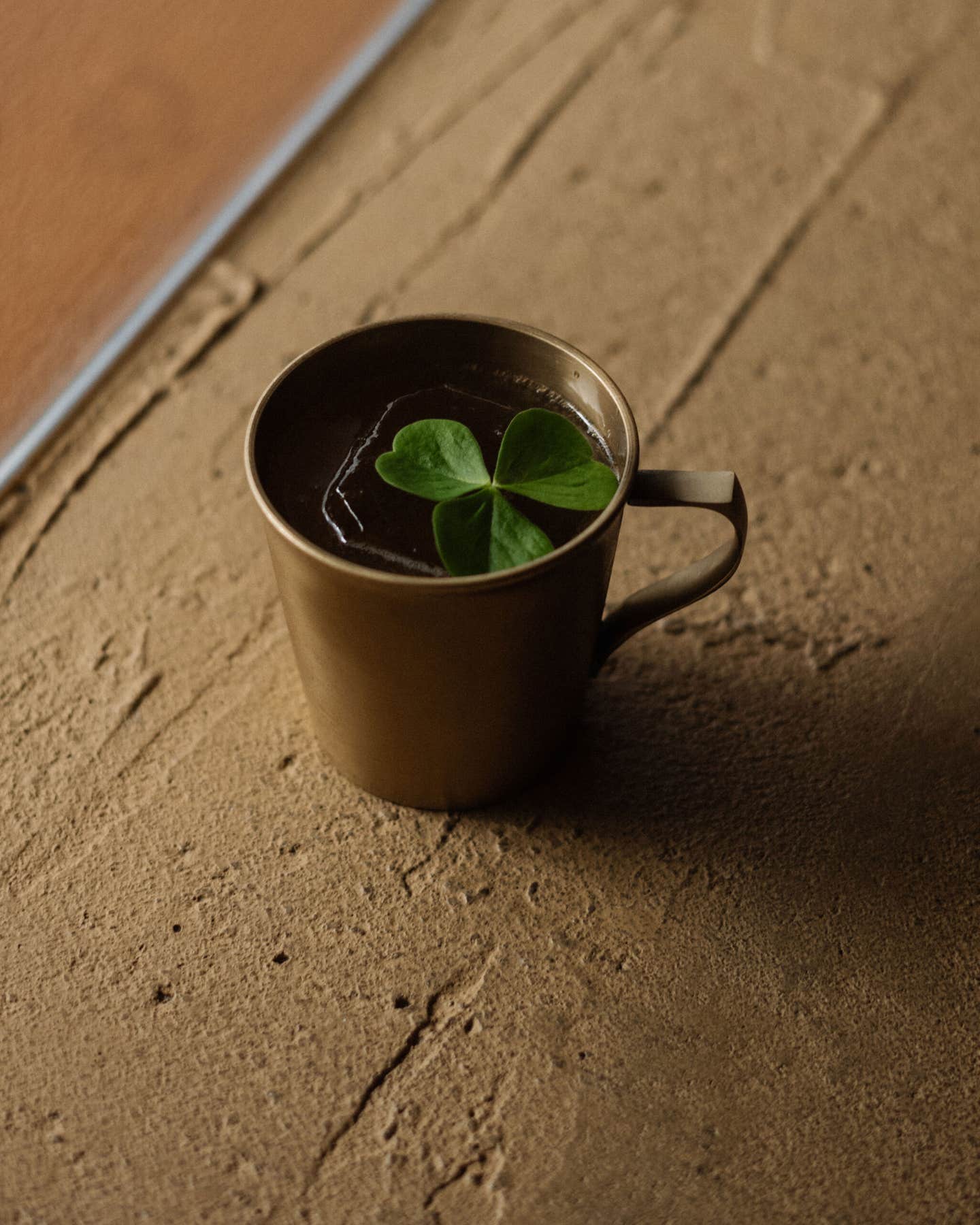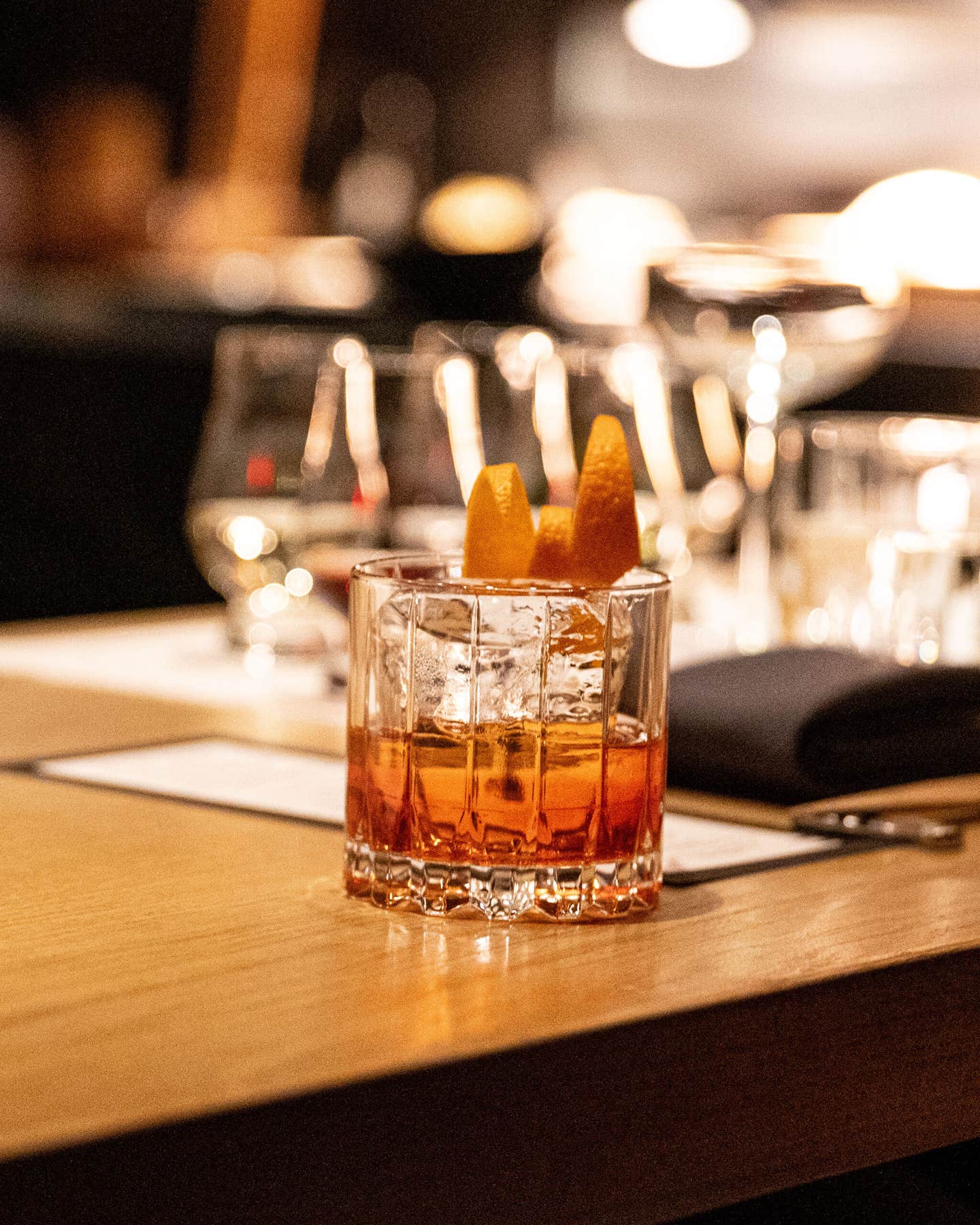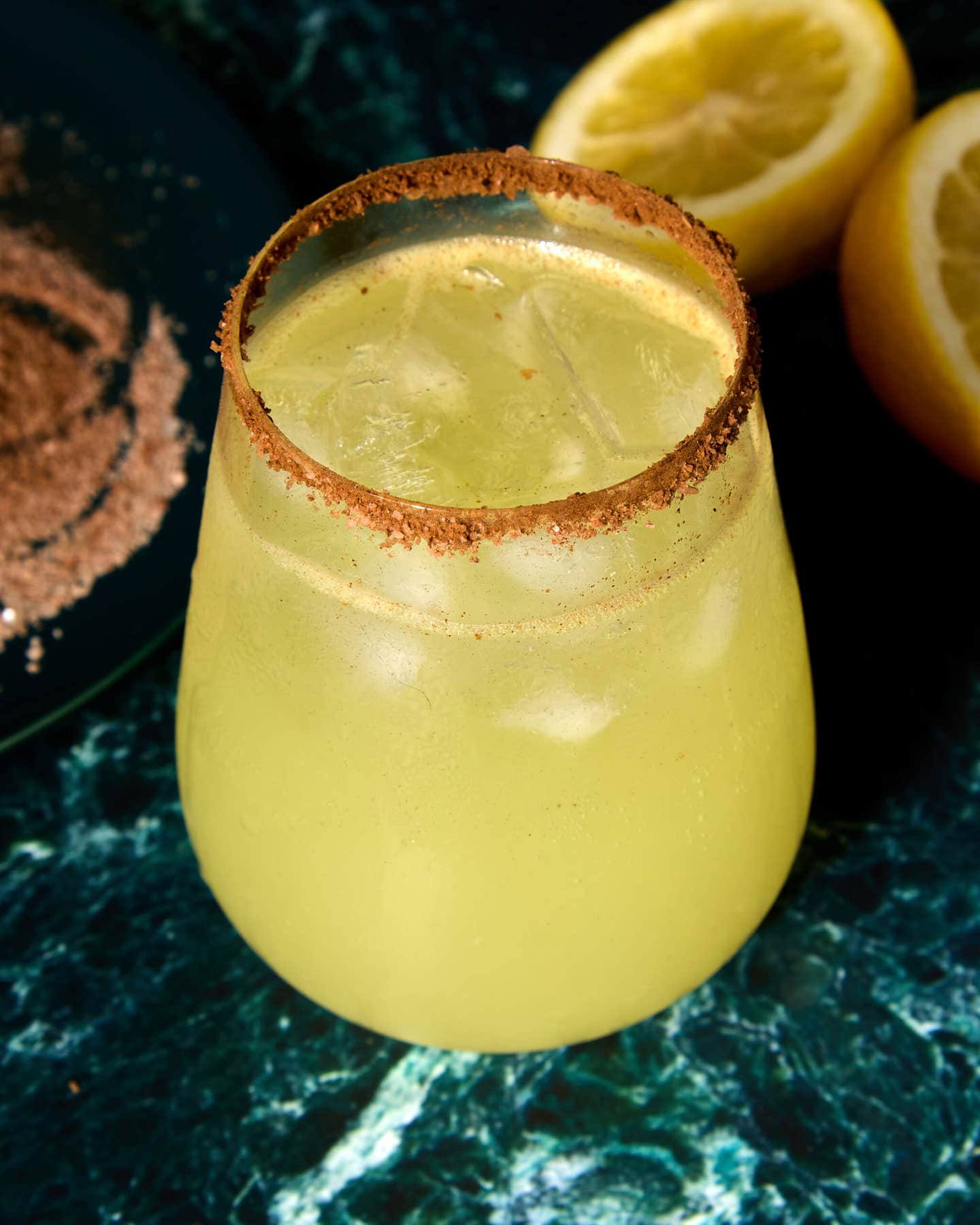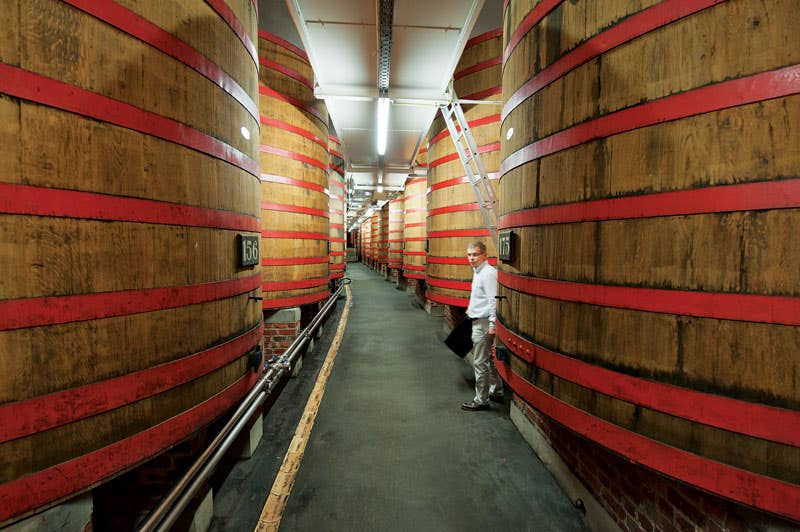
Apparently, I needed guidance. It was late on my first night in Flanders, Belgium's Dutch-speaking northern region. Gothic spires punctured the clouds over the city of Antwerp. I had dined at De Groote Witte Arend, a restaurant that specializes in dishes cooked with and paired with beers. I was full and drowsy. But having heard that a bar called Bierhuis Kulminator had perhaps the world's greatest stash of rare Belgian beers, I had ventured there for a nightcap. Intimidated by the shelves packed with corked bottles, I stared, at a loss, at the tome-like beer list. An older gentleman sitting at the bar pointed at his glass.
"Fresh, fresh! You must drink your beer fresh from the keg!" It was a warm spring night, but he ordered me a Christmas draft—a Bush de Noel from Brasserie Dubuisson, at 243 years old the most ancient brewery in Wallonia, the French-speaking part of Belgium. Rich as molasses but offset by brisk spice, it was far too drinkable at 12.5 percent alcohol. "It will help you sleep," the white-haired chap said. "Op uw gezondheid." To your health.
"We are Burgundian," he added, referring to the era when the Dukes of Burgundy ruled Belgium, in the 14th and 15th centuries, ushering in prosperity and high culture. "That's why we like fine things."
It was not the only time someone would say this to me over a beer in Belgium. In a week of quaffing my way across Flanders and Brussels, I would come to understand that Belgians prize refinement. Like many people, I once thought of Belgian beer as heavy and sweet. And there was a time not too long ago when commercialization had led to homogenization. But for the bulk of its history, and again today, Belgian brewing has been a many-splendored art. In its myriad styles, from light wheat beers and sour ales to malt-rich dubbels and tripels, true Belgian beer is a beautifully balanced drink. Never too sweet or too bitter, too thick or too crisp, but exhibiting all of those qualities in measured amounts. So much flavor, yet so much elegance. For me, it was a delicious education.
From what brewers and beer lovers told me, I had happened upon the country at the best time in over half a century to experience this balance. After decades dominated by industrial lagers and treacly ales, Belgium is returning to basics, with a reinvigorated interest in local artisanal beer. New brewers are making it, and young drinkers are expressing newfound curiosity about this bona fide national treasure.
In December 2011—the last time Zythos, Belgium's association of beer consumers, counted—there were 146 breweries here. That's more breweries per capita than just about anywhere else on earth. Beer's raw materials, which can include barley, wheat, and other grains, thrive in chilly Belgium. Farmers and monks have brewed here for centuries, and in the bustling towns of the Burgundian era, beer making thrived. In 1847, economist John Ramsay McCulloch reported of Belgium, "Beer is the common beverage of all classes." It is so much a part of the culture that, up until the 1980s when soft drinks replaced it, children drank low-alcohol beer in school.
Given Belgian history, you can't blame folks for wanting to unwind with an ale. "If you're invaded as much as they are, and have so many neighbors doing the same thing as you—I mean, there are many breweries in this small country—you do two things," Wendy Littlefield, an American importer, explained as we drove through Dendermonde, a city with a typical Flemish past: It was sacked by the Spanish in 1572, sacked by the French and British a century later, and bombed during World War I. "You keep your own counsel, and you don't get too competitive."
History, in other words, has made Belgians risk averse. When they find a good thing, they stick with it, quietly polishing its potential. There are hundreds of different beers made in Belgium. Many of these share basic characteristics, and can be categorized for labelling and marketing purposes. But as one brewer told me, "Belgians don't ask about style. It's not in our culture. People focus on taste."
Independent-minded and anti-categorical, Belgians have evolved a particular approach to brewing. In The Oxford Companion to Beer, author Garrett Oliver says of the country, "Many brewers seem to be radical and conservative at once, unwilling to try anything new, yet still creating beers that taste like no one else's."
Littlefield and I had just come from a visit to Anne-Catherine Dilewyns, at 25 years old Belgium's youngest brewery owner. With its brand-new, Italian-made equipment set in a glass-fronted warehouse surrounded by auto dealerships, the year-old Brouwerij Dilewyns doesn't look traditional. But Dilewyns is not an upstart; hers is a family trade. Her great-great-great-great-grandmother founded a brewery that ran until the Second World War, when the Germans swiped her copper kettles. The quality of Dilewyns' beer, expressed in the roasty depth and subtle astringency of her flagship ale, Vicaris Generaal, comes from traditional Flemish brewing techniques. Dilewyns does not filter, a practice used widely in other countries to achieve clarity, stability, and consistency. The turbidity of her beers comes from the rich organic matter—yeast, hops, and other flavor components—from which they're made.
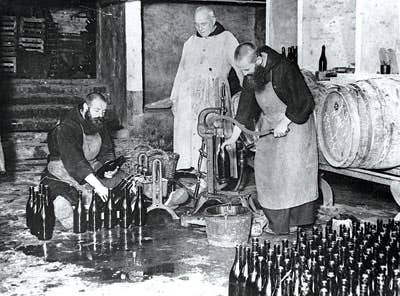
credit: Hulton-Deutsch Collection/Corbis
Dilewyns threw open the door to the brewery's warm room, releasing a rush of hot, bready air. We were witnessing another great Belgian technique: bottle conditioning. Beer is a fermented drink; it's created by introducing yeast to a wort, a rich liquid made by running hot water over malted grains to release their sugars, on which the yeast feeds. The bubbles in beer are the by-product of the yeast's work. Normally beer is fermented in tanks. But in Belgium, following tank fermentation, new yeast and sugar are added to induce the brew to ferment again in the bottle, yielding silky carbonation and fertile complexity. The warm room felt pregnant; it was teeming with life. Belgium's robust ale yeasts—aided by balmy fermentation environments—yield spicy, fruity, intricately flavored beers. They're yeasts worth caring for.
"You have a communion because you work with something that is alive. I speak to my yeast, it's true." Yvan De Baets was showing me the unusually wide fermentation tanks he uses at Brussels's Brasserie de la Senne. The tall, narrow tanks at other breweries "put physical pressure on the yeast," he said. "That releases strong aromas."
I figured Baets knew of what he spoke; the beers from his eight-year-old brewing company have incomparable aromas. The night before, I'd eaten at a beer-focused restaurant in Brussels called Restobieres. With my steak in mustard-beer sauce I was served a malty Jambe-de-Bois from Brasserie de la Senne that smelled of barley. Now, as Baets poured me his hops-rich Zinnebir pale ale, I told him, "It smells like hashish."
Hops are related to cannabis, Baets pointed out. Hop bitterness is important to this young brewer; it embodies tradition. "We always had bitter flavors in Belgium," he told me. "Hops were used as preservatives. But we nearly lost those flavors in the 1970s, when Belgian beer was almost totally in the hands of big beer companies that made a bland, sweet product everyone would drink. Now, it's changing again. Young people feel they've been manipulated. They hate that. And they're drinking our beer." Being Belgian, he hastened to add, "We make hoppy beers but not extreme beers. The hops are always balanced with malt."
Balance, tradition, and sly innovation: At De Dolle Brouwers, in Esen, these themes coalesced. Here, the craggy-faced Kris Herteleer brews using rustic equipment from the 1920s. Fermenting beer bubbled like witch's brew in an old open tank. Everything seemed ancient and creaky. And yet Herteleer's beer is arrestingly novel, polished, and brisk. Reminiscent of Rodenbach—the famously wine-like Flemish sour ale from Herteleer's hometown of Roeselare—his Oerbier Special Reserva is wonderfully tart, but made with a complex recipe including seven different malts, it's also rich and creamy, with an edgy bite. At Rodenbach, the beer is aged in wooden casks, some more than 17,000 gallons in volume; here, Herteleer uses old Bordeaux wine casks. "We are traditional," he told me. "But we don't make beer like they did 100 years ago. We have two labs to control everything. And we bet on the quality of our ingredients."
Ingredients are top-of-mind for Joris Cambie, too. Perhaps Belgium's newest brewer, Cambie is the co-owner of Brouwerij De Plukker. He's also an organic farmer, in the hops-growing region near the French border. (The name of his brewery means "the picker.") It was March when I visited him. Six-meter poles strung with wires rose from his fields like the rigging of tall ships. They were the frames that his hop vines would climb on, erupting with green blossoms and filling the air with their herbal aroma by the September harvest. Now new shoots were just piercing the dirt. I'd spotted the same bittersweet sprouts on local menus. I had eaten them with sole a la viennoise in a wheat beer sabayon at a restaurant called Pegasus, in the town of Poperinge. In Watou, at 't Hommelhof, hops shoots were marinated in hoppy ale and tucked between slices of veal in a Flemish twist on vitello tonnato that swapped the tuna sauce for smoked eel pate.
Cambie led me to a shed where he keeps his tiny beerworks. The month prior, he had released his first batch. The dark-blonde ale, called Keikoppenbier, has a delicate, floral hop finish. "We're in a different climate than Washington State's hops-growing area," Cambie said, offering a comparison he figured his American guest would understand. "Our flowers are softer, milder, and sweeter. We prefer that. I wanted to make a beer that is very drinkable."
Historically, farmers who grew barley and hops brewed beer in winter for their workers to drink in summer. That tradition begat today's thirst-quenching saisons, or farmhouse ales, from Wallonia. In Flanders, though, where saisons are not brewed, Cambie's farmstead beer is unique—and much appreciated. He gestured to pallets of bottles. "All of this is sold already," he said.
Cambie's efforts are the latest indication of a small revolution in Belgian beer. A handful of other new craft breweries—De Dochter van de Korenaar, on the Dutch border, brewer of one of Belgium's only smoked beers; Ghent's Gruut brewpub, whose herb-based beers hark back to medieval styles; Alvinne, where they make liberal use of hops and spices—are turning out fascinating bottles, many of which find their way to this country. America's thirst for these beers is, in fact, responsible for much of Belgian brewing's newfound energy. But the enthusiasm is also catching at home, even for the most ancient of styles, lambic—the drink depicted in the paintings of the Flemish old master Pieter Bruegel.
There was a time when the cider-like lambic—which is fermented in open vessels by specific wild yeasts that thrive only in the vicinity of Brussels—was in danger of extinction. But in the village of Beersel, southwest of Brussels, Armand Debelder of 3 Fonteinen brewery, a longtime lambic producer, had reason to celebrate. He was toasting plans for his 28-year-old protege, Michael Blancqaert, to succeed him. Debelder uncorked a bottle of his 1997 vintage gueuze, a blend of young and old lambics. The hazy apricot-hued beer revealed itself slowly in a few sips. There was a nuttiness to it that recalled an amontillado sherry, and then blonde butterscotch, green apples, and a trace of delicious funkiness that gueuze makers describe as "horse blanket."
"The younger generation is coming to know this type of beer now," Blancqaert said. "People want to taste something special."
To that, Debelder raised his glass: "Herman Teirlinck, the late, great Flemish poet, said, 'In our tradition, we also have taste.'"
Keep Reading
Continue to Next Story






